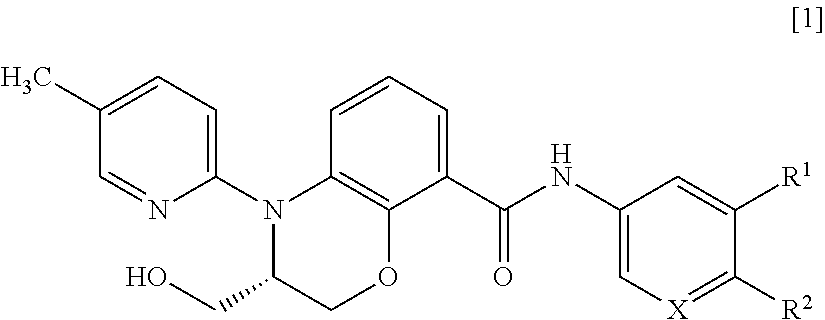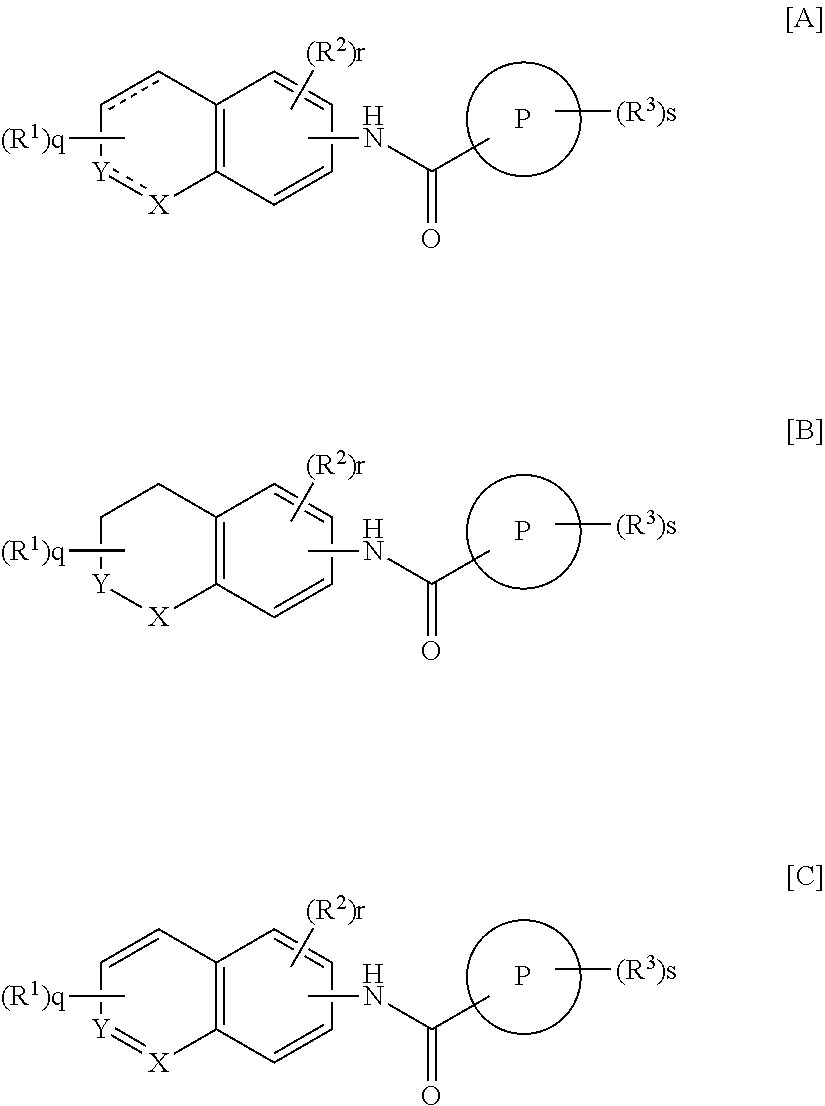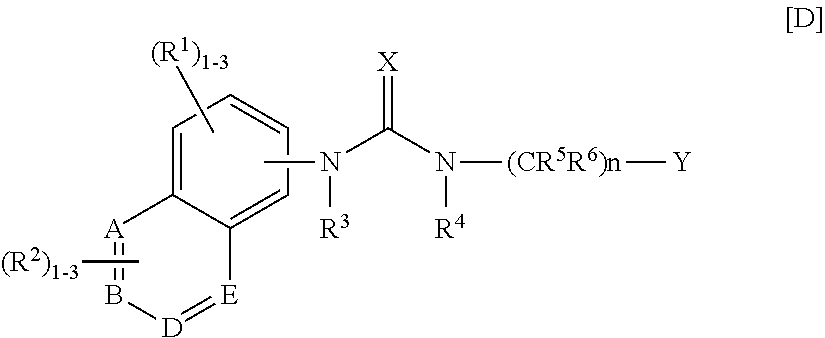3,4-dihydrobenzoxazine compounds and inhibitors of vanilloid receptor subtype 1 (VRI) activity
a vanilloid receptor and inhibitory technology, applied in the field of new drugs, to achieve the effect of effective inhibition of vanilloid receptors, excellent inhibitory effect on vr1 activity, and effective medical treatment and/or prevention
- Summary
- Abstract
- Description
- Claims
- Application Information
AI Technical Summary
Benefits of technology
Problems solved by technology
Method used
Image
Examples
example 1-1
Production of (S)-4-(5-picoline-2-yl)-3-hydroxymethyl-N-(4-tert-butoxy-3,5-difluorophenyl)-3,4-dihydro-2H-benzo[1,4]oxazine-8-carboxamide
First Step
Production of methyl 3-nitrosalicylate
[0185]3-Nitrosalicylic acid (500 g) was dissolved in methanol (2.25 L), concentrated sulfuric acid (0.25 L) was added, and the mixture was refluxed for 22 hours. The reaction solution was cooled on ice, and the precipitated solid was collected by filtration and dried to obtain the title compound (517.3 g).
[0186](400 MHz, DMSO-d6): 3.95 (s, 3H), 7.16 (t, J=8.1 Hz, 1H), 8.11 (dd, J=7.9, 1.9 Hz, 1H), 8.21 (dd, J=8.3, 1.9 Hz, 1H), 11.49 (s, 1H).
Second Step
Production of methyl 2-(2-methoxyethoxy)methyloxy-3-nitrobenzoate
[0187]Methyl 3-nitrosalicylate (516.3 g) obtained in the preceding step was dissolved in N,N-dimethylformamide (2.0 L), potassium carbonate (362 g) was added, 1-chloromethoxy-2-methoxyethane (0.329 L) was further added with stirring under ice-cooling, and the mixture was stirred at room tem...
example 1-2
Production of (S)-4-(5-picoline-2-yl)-3-hydroxymethyl-N-(3,5-difluoro-4-isopropoxyphenyl)-3,4-dihydro-2H-benzo[1,4]oxazine-8-carboxamide
[0199](S)-4-(5-picoline-2-yl)-3-hydroxymethyl-3,4-dihydro-2H-benzo[1,4]oxazine-8-carboxylic acid (400 mg) obtained in the Seventh Step of Example 1-1 was dissolved in N,N-dimethylformamide (2 mL). 3,5-Difluoro-4-isopropoxyaniline (249 mg), 1-hydroxybenzotriazole (204 mg) and 1-ethyl-3-(3-dimethylaminopropyl)-carbodiimide hydrochloride (281 mg) were added in this order and the mixture was stirred overnight at room temperature. Water and a saturated sodium hydrogencarbonate solution were added to the reaction solution and then extracted with ethyl acetate. The ethyl acetate layer was washed with a saturated sodium chloride solution, dried over anhydrous magnesium sulfate and then concentrated. The residue was purified by silica gel chromatography (hexane:ethyl acetate=4:3) to obtain the title compound (332 mg).
example 1-3
Production of (S)-4-(5-picoline-2-yl)-3-hydroxymethyl-N-(3,5-difluoro-4-ethoxyphenyl)-3,4-dihydro-2H-benzo[1,4]oxazine-8-carboxamide
[0200](S)-4-(5-picoline-2-yl)-3-hydroxymethyl-3,4-dihydro-2H-benzo[1,4]oxazine-8-carboxylic acid (400 mg) obtained in the Seventh Step of Example 1-1 was dissolved in N,N-dimethylformamide (2 mL). 3,5-Difluoro-4-ethoxyaniline (230 mg), 1-hydroxybenzotriazole (204 mg) and 1-ethyl-3-(3-dimethylaminopropyl)-carbodiimide hydrochloride (281 mg) were added in this order and the mixture was stirred overnight at room temperature. Water and a saturated sodium hydrogencarbonate solution were added to the reaction solution and then extracted with ethyl acetate. The ethyl acetate layer was washed with a saturated sodium chloride solution, dried over anhydrous magnesium sulfate and then concentrated. The residue was purified by silica gel chromatography (hexane:ethyl acetate=5:4) to obtain the title compound (358 mg).
PUM
 Login to View More
Login to View More Abstract
Description
Claims
Application Information
 Login to View More
Login to View More - R&D
- Intellectual Property
- Life Sciences
- Materials
- Tech Scout
- Unparalleled Data Quality
- Higher Quality Content
- 60% Fewer Hallucinations
Browse by: Latest US Patents, China's latest patents, Technical Efficacy Thesaurus, Application Domain, Technology Topic, Popular Technical Reports.
© 2025 PatSnap. All rights reserved.Legal|Privacy policy|Modern Slavery Act Transparency Statement|Sitemap|About US| Contact US: help@patsnap.com



